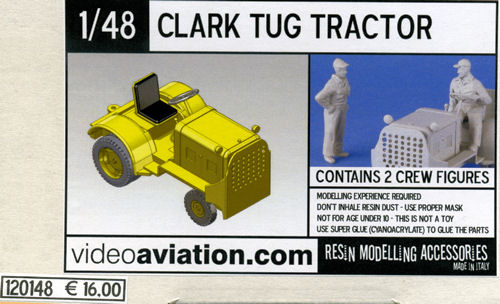
| KIT #: | 120148 |
| PRICE: | 16.00 Euros from www.videoaviation.com |
| DECALS: | None |
| REVIEWER: | Scott Van Aken |
| NOTES: | Resin kit |

| HISTORY |
Though it seems like everyone and his mother knows about these airfield tow tractors/tugs, finding any sort of comprehensive historical background on them proved to be nearly impossible. These tugs are known as either Clark or Clarktor and seem to have been made in several models, most of which look to be pretty much the same.
The Clarktor 21/40/46 model was manufactured from 1949 through 1962. Essentially a re-designed Clarktor-6, the fuel tank was located under the driverís seat. Clarktor 21/40/46 models were also powered by Chrysler six-cylinder engines.
From 1927 until 1983, almost all Clarktors were
manufactured at a Clark plant in Battle Creek, Michigan. That Battle Creek
facility was originally known as the Clark Tructractor Division of the Clark
Equipment
Company.
This kit fits into any diorama from Korea through Vietnam. You can even pretend it is the WWII vintage Clark 6 as it looks pretty much the same. These were used by all military services, but were not seen on aircraft carriers (that I know of) due to their size. Carrier tugs are usually very low and earlier carrier tugs looked like three wheel Jeeps with a single wheel in the back for easy maneuverability.
Here are some specs on the Clarktor 6 and should be similar to the later models.
Length: 8 feet 4 inches
Width: 5 feet 5 inches
Height: 4 feet 8 inches
Wheelbase: 59 inches
Crew: 1
Weight: 4,700 lbs
Drawbar Pull: 4,000 lbs
Towing Capacity, Level Surface: 90 tons
Max Speed: 12 mph
Powerplant: Inline Water Cooled 6 cylinder 230ci Gas Engine 63hp
Fuel Capacity: 6 gallons
Entered Service: 1942
| THE KIT |
 Maurizio
Amelotti of
www.videoaviation.com has decided to go into the diorama
accessory business with resin kits and this is his first one. It is an excellent
choice due to its widespread use. The kit is full resin and consists of 22
superbly molded parts. These are free of any sort of molding issues and though
some with require a bit of sanding or sawing to remove from the sprue block, the
fit should be superb.
Maurizio
Amelotti of
www.videoaviation.com has decided to go into the diorama
accessory business with resin kits and this is his first one. It is an excellent
choice due to its widespread use. The kit is full resin and consists of 22
superbly molded parts. These are free of any sort of molding issues and though
some with require a bit of sanding or sawing to remove from the sprue block, the
fit should be superb.
The parts are well protected by blocks on the end of the fragile bits sprues and the main engine section is wrapped in foam wrapping. There is a one piece chassis onto which separate fenders and running board are attached. The motor section has the pedals molded into the back side and it is here that the air filter and steering assembly is attached. Two steering wheels are provided in case a spare is needed. There is a metal rod (not shown) for the steering column.
The front has the usual metal push grille while on the back there is a rear bumper on which your choice of towing hook can be attached. While not all had this, a separate rear plate is provided should you wish to use it. While the painting guide shows it as overall yellow, there are cases of other colors being used so check your references. A very nice touch is the addition of two figures in overalls. One is a driver figure and the other must be the boss as he is standing with his hands on his hips!
Instructions are superbly drawn and show precisely where all the various pieces are to be attached. There are no decals, but then these rarely had them. If you need markings, you can probably print your own or check for suitable ones from Archer or other decal makers.
| CONCLUSIONS |
It is a superb initial item and as the moment, only available in 1/48 scale, though others are planned.
November 2012
Thanks to www.videoaviation.com for the review kit. You can buy this one direct from this link.
If you would like your product reviewed fairly and fairly quickly, please contact the editor or see other details in the Note to Contributors.